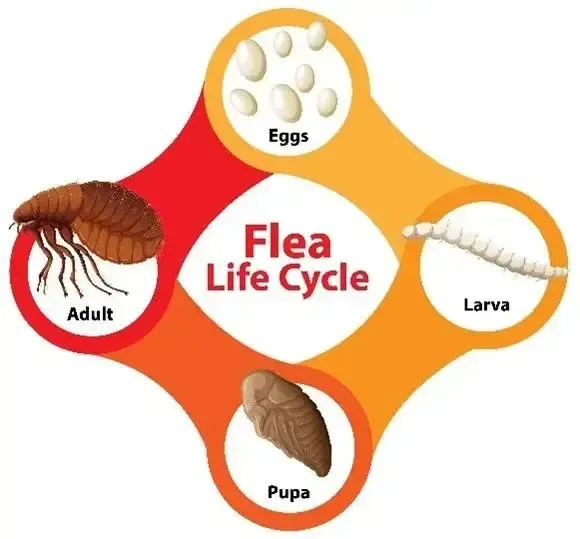Are fleas hiding in your carpet? Warning signs and what to do
When you think of fleas, do you start to itch?? For such small beasties, their superpower is they can instantly make you feel the need to scratch. If these unwelcome squatters are living in your home, we know it’s no laughing matter!
And while we usually first think of cats and dogs as the culprits, pet rabbits and rodents can also host fleas.
Whether you own pets or have recently moved into a new home, fleas silently infest carpets, upholstery, and bedding, so understanding the warning signs and acting quickly is critical to preventing a widespread infestation.
In this guide, Advanced Carpet Cleaning explain how carpet flea infestations occur, the signs to watch for, and why professional carpet cleaning and pest control in Christchurch is the safest and most effective solution.

Seven warning signs of fleas in your home
It’s estimated that only around 5% of resident fleas will be visible so waiting until you sight them may be giving the other 95% just the undisturbed freedom they want! So, if you can’t always see them, how would you know they’re there?
Aside from spotting fleas directly, there are several indicators of a hidden infestation to stay vigilant for:
- Itchy bites on skin – often around the ankles, legs, or waistline that may appear in clusters or lines.
- Pets scratching or biting themselves; they may scratch excessively or chew their skin causing a bald spot.
- Flea dirt (droppings) in carpets or bedding - tiny black or dark brown specks that turn reddish when moistened indicate flea waste.
- Seeing fleas jumping.
- Unexplained restlessness in pets, they seem agitated or are reluctant to settle in their usual spots.
- Flea eggs or larvae visible in fabrics or seen in the vacuum cleaner chamber (though they can be hard to spot).
- Itching after sitting on sofas, chairs, or beds may indicate fleas are hiding in the upholstery.
Isn’t it too cold in Christchurch for fleas?
While they thrive in warmer climates than Christchurch, they are still prevalent here during spring and summer through to early autumn. Theoretically, in cooler weather flea activity should slow down but infestations persist indoors because we like our homes nice and warm and there’s an abundance of host animals (yes, that means you) who are indoors for more of the time.
How do fleas find their way into your home?
If you are a pet owner, a flea problem is almost expected at some point during the lifetime of your pet. However, non-pet households aren’t immune.
Fleas may also have been in the carpet before you moved in, if previous occupants had pets. Do you know if a pre-settlement or an end of tenancy carpet clean and flea treatment was completed before you arrived?
These opportunistic pests can arrive in your abode via numerous other ways:
Animals
Cats and dogs can pick up fleas after playing outside in areas with other infested animals. Your own pets, visiting pets or feral cats and stray animals in your yard can start an infestation.
Humans
Fleas can hitch a ride into your home on clothes or on shoes after walking through outdoor areas where they is an infestation.
Pre-owned items:
We all love a bargain from an op shop, but fleas can also be brought in on used furniture or fabrics and textiles that have been exposed to an infestation.
Dormant fleas:
Flea pupae can remain dormant for extended periods, up to nine months, hatching in response to the vibrations and heat from a person or pet entering the home. These pesky pests can go into preservation mode if food is scarce – and become full of beans again when people and animals move around indoors.

Flea life stages: why early detection matters
Once inside your home, fleas reproduce rapidly. Pet bedding as well as carpets, rugs, blankets and upholstered furniture are the ideal breeding ground for these most persistent of household pests.
A single female flea can lay up to 50 eggs a day, which fall into carpets, furniture, and crevices. These eggs hatch into larvae that feed on organic debris, eventually becoming adult fleas capable of biting humans and pets alike, and of course reproducing. Understanding the flea life cycle is fundamental to effective control. Fleas go through four main stages:
Eggs: female flees can lay eggs within 48 hours of their first blood feed. The eggs are tiny, white, and near invisible; unlike other insects, their eggs are not sticky, so they fall off pets onto carpets, rugs, and bedding. Eggs hatch between 1 and 12 days depending on their environment. Cold environments cause the eggs to perish.
Larvae: these small maggot-like larvae are whitish when they first hatch but turn progressively darker as they feed (Gross Details Alert!) on the faeces of the adult fleas and organic matter – dead skin cells and pet dander etc. They are light-sensitive, which encourages them to burrow deep into carpet fibres and upholstery. This stage lasts between 4 to 18 days. The larvae do not survive relative humidity less than 45-50 percent or temperatures greater than 95 degrees (hello carpet and upholstery steam cleaning).
Pupae: the larvae encase themselves in cocoons, and these pupae can survive for up to a year as they transform into adult fleas. This is the hardest stage of a flea’s life cycle to treat, as the cocoon protects from insecticides and environmental factors.
Adults: small, reddish-brown, and highly mobile, adult fleas feed from the blood of their host as soon as they come out of the pupal stage. This is when they bite pets and humans. With the right conditions and a host to feed from, fleas can live up to three months.
You can see from this life cycle how why vacuuming alone won’t deal to fleas. And because eggs and larvae are hidden and hard to spot, DIY methods like flea-bombing and sprays often don’t reach all the places where fleas and eggs will be hanging out. Professional carpet pest management measures are needed to fully eliminate fleas at all life stages.
Professional flea treatment, for your protection
Fleas are more than a minor nuisance, they’re a persistent pest that thrive in hidden places like carpets, rugs, and upholstery. That’s why professional flea treatment is the safest and most reliable solution, in conjunction with flea treating pets, and hot washing pet bedding and other possible host items.
If your carpet is due for a clean, this should be done before the flea treatment – professional steam cleaning can help reduce an infestation, but applying a spray to the carpet which interferes with the pest’s life cycle is the only way to get rid of an infestation.
With comprehensive coverage of every flea life stage, Advanced Carpet Cleaning’s pest control treatments ensure your home is free of carpet pests like fleas. For your protection, NZ law requires applicators to be NZQA-certified to complete a flea treatment. This ensures the application is completed safely and thoroughly. Our business is accredited by NZQA to complete carpet pest management, including fleas.
Book your appointment and enjoy the confidence of a cleaner, healthier, flea-free home. Call 0800 566 576 – we’re more than happy to help.
Our services







